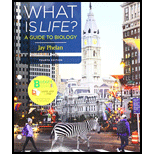
To analyze:
Why the development of the membrane system was an important phase in the origin of life.
Introduction:
The membrane system refers to the membrane bound organelles seen in all eukaryotic cells.
Answer to Problem 1SA
Correct answer:
Option (a): amino acids.
Explanation of Solution
The formation of the first membrane around chemical components lead to the formation of the first cells. This started life on earth. When membrane systems developed around cells, it allowed more complexity to come into life processes.
The different chemical components within cells began to be enclosed within lipid membranes. This created specialized structures called organelles.
The development of the cell membrane allowed the cell to regulate the molecules that could interact with the cell components, allowing access to required chemicals, while inhibiting others that were injurious to the cell and its components.
Specialized functions evolved in the cells, and the cells in turn grew specialized for various functions. This may have been what led to the evolution of multicellular organisms. This development is considered an important phase in the origin of life.
The separation of different chemical components within a cell by membranes lead to the evolution of organelles. This is an important phase in evolution because it led to the increase in complexity of life processes.
Want to see more full solutions like this?
Chapter 12 Solutions
Loose-leaf Version for What Is Life? A Guide to Biology
- Noggin mutation: The mouse, one of the phenotypic consequences of Noggin mutationis mispatterning of the spinal cord, in the posterior region of the mouse embryo, suchthat in the hindlimb region the more ventral fates are lost, and the dorsal Pax3 domain isexpanded. (this experiment is not in the lectures).a. Hypothesis for why: What would be your hypothesis for why the ventral fatesare lost and dorsal fates expanded? Include in your answer the words notochord,BMP, SHH and either (or both of) surface ectoderm or lateral plate mesodermarrow_forwardNot part of a graded assignment, from a past midtermarrow_forwardNot part of a graded assignment, from a past midtermarrow_forward
- please helparrow_forwardWhat does the heavy dark line along collecting duct tell us about water reabsorption in this individual at this time? What does the heavy dark line along collecting duct tell us about ADH secretion in this individual at this time?arrow_forwardBiology grade 10 study guidearrow_forward
 Concepts of BiologyBiologyISBN:9781938168116Author:Samantha Fowler, Rebecca Roush, James WisePublisher:OpenStax College
Concepts of BiologyBiologyISBN:9781938168116Author:Samantha Fowler, Rebecca Roush, James WisePublisher:OpenStax College Human Biology (MindTap Course List)BiologyISBN:9781305112100Author:Cecie Starr, Beverly McMillanPublisher:Cengage Learning
Human Biology (MindTap Course List)BiologyISBN:9781305112100Author:Cecie Starr, Beverly McMillanPublisher:Cengage Learning Biology Today and Tomorrow without Physiology (Mi...BiologyISBN:9781305117396Author:Cecie Starr, Christine Evers, Lisa StarrPublisher:Cengage Learning
Biology Today and Tomorrow without Physiology (Mi...BiologyISBN:9781305117396Author:Cecie Starr, Christine Evers, Lisa StarrPublisher:Cengage Learning Biology (MindTap Course List)BiologyISBN:9781337392938Author:Eldra Solomon, Charles Martin, Diana W. Martin, Linda R. BergPublisher:Cengage Learning
Biology (MindTap Course List)BiologyISBN:9781337392938Author:Eldra Solomon, Charles Martin, Diana W. Martin, Linda R. BergPublisher:Cengage Learning





